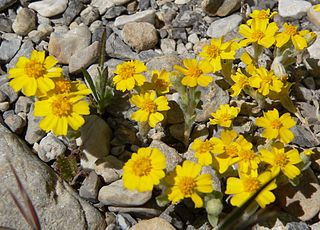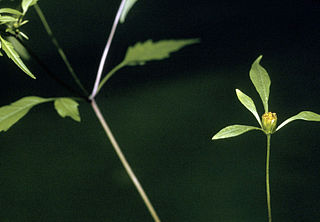
Encelia farinosa, is a common desert shrub of northern Mexico and the southwestern United States.

Cirsium arizonicum, the Arizona thistle, is a North American species of thistle in the sunflower family, native to the southwestern United States and northwestern Mexico. It has been found in Arizona, southeastern California, New Mexico, Nevada, Colorado, Utah, Sonora, and northwestern Chihuahua.

Eriophyllum wallacei is a North American flowering plant in the family Asteraceae known by the common names woolly daisy and woolly easterbonnets. It grows in the southwestern United States and northwestern Mexico.

Encelia californica is a species of flowering plant in the family Asteraceae known by the common name California brittlebush. It is also commonly referred to as California coast sunflower and California bush sunflower.

Encelia virginensis is a North American species of flowering plants in the family Asteraceae known by the common name Virgin River brittlebush. This shrub is native to the southwestern United States and northwestern Mexico, particularly the Mojave Desert and the Sonoran Desert. It has been found in Baja California, southern California, Nevada, Arizona, southwestern Utah, and southwestern New Mexico.

Chamaechaenactis, common name fullstem, is a genus of flowering plants in the daisy family.
Tetraneuris scaposa is a North American species of plants in the sunflower family. It grows in the southwestern and south-central United States and northern Mexico.
Bahia bigelovii, or Bigelow's bahia, is a North American species of flowering plants in the family Asteraceae. It is native to the State of Coahuila in Mexico and to the western (trans-Pecos) part of the US state of Texas.

Bidens discoidea, the small beggarticks, is a North American species of flowering plant in the family Asteraceae. It is widespread across eastern Canada and the eastern and central United States, from Nova Scotia west to Minnesota, south to Florida and Texas.
Bidens lemmonii is a North American species of flowering plant in the family Asteraceae. It is native to the southwestern United States and Mexico.
Bidens tenuisecta , the slim lobe beggarticks, is a North American species of flowering plant in the family Asteraceae. It is native to northern Mexico (Chihuahua) and the western United States. There are also reports of populations in the northeastern United States but these are almost assuredly introductions.

Brickellia brachyphylla, the plumed brickellbush or Hinckley's brickellbush, is a North American species of flowering plant in the family Asteraceae. It is native to the southwestern United States, in Arizona, New Mexico, Colorado, western Texas, and the Oklahoma Panhandle. There are reports that it formerly occurred in southwestern Kansas, but these populations appear to be extinct.

Elephantopus nudatus, common name smooth elephantsfoot, is a North American species of flowering plant in the sunflower family. It is native to the southeastern United States from eastern Texas to Delaware.

Encelia nutans, called noddinghead, or nodding sunray, is a North American species of flowering plants in the family daisy family. It has been found only in Utah and Colorado in the western United States.

Ericameria resinosa, the Columbia goldenweed, or Columbia goldenbush, is a North American species of flowering shrubs in the daisy family. It is native to the northwestern part of the United States, in the states of Washington, Oregon, and Idaho.
Ericameria watsonii is a North American species of flowering shrubs from the daisy family. It is native to the states of Nevada, Utah, and Arizona in the southwestern United States.

Ericameria palmeri is a North American species of flowering shrubs in the daisy family. It is native to southern California in the United States and to the state of Baja California in Mexico.

Erigeron arenarioides is a species of flowering plant in the family Asteraceae known by the common names sand fleabane and Wasatch fleabane. It has been found only in the northern part of the state of Utah in the western United States.
Helianthus laciniatus is a North American species of sunflower known by the common name alkali sunflower. It is found in the southwestern United States and north-central Mexico. It is fairly common in the Chihuahuan Desert.
Tetraneuris linearifolia is a North American species of plants in the sunflower family, known by the common name fineleaf fournerved daisy. It grows in the south-central United States and northern Mexico.












